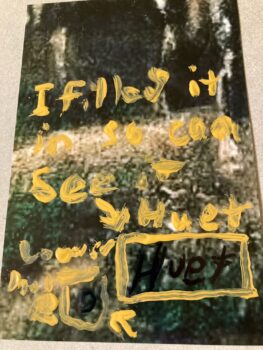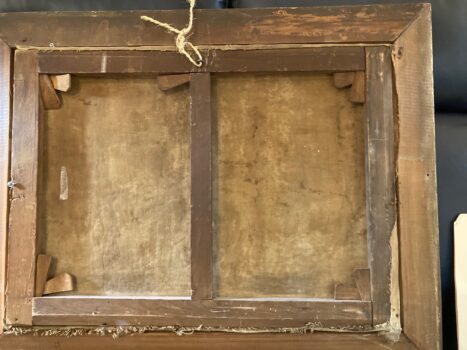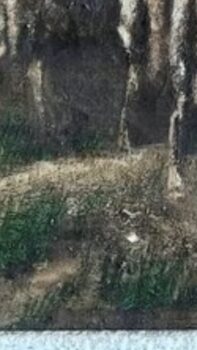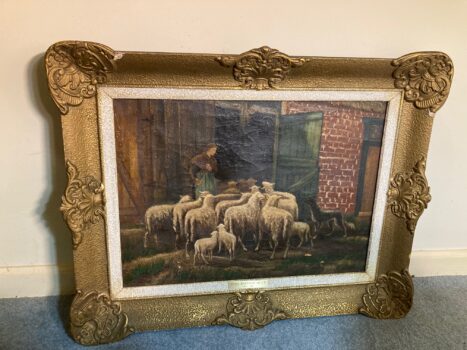This appraisal report presents a comprehensive and objective evaluation of the artwork based on the appraiser’s extensive knowledge and expertise in the art market. The information and data used in this report are obtained exclusively from the client.
Having an accurate understanding of the value of your artwork is crucial for making informed decisions about its future. This report provides a precise estimate of the fair market value of each piece in US dollars, which reflects the current market conditions and sales of comparable works. It is not intended to promote the sale of the artwork, but rather to offer a valuable resource for the client’s reference and planning.
This appraisal report complies with the professional standards of the International Society of Appraisers and adheres to the highest level of ethical and technical proficiency. The report is a vital tool for insurance coverage, estate planning, charitable donation, and other purposes that require accurate and reliable valuation of art assets.
Detailed description of the artwork, including its medium, dimensions, and condition.
Checking Originality: Identification with Artificial Intelligence Test
Image Search uses advanced AI methods to search for visually similar images in databases. This is accomplished through the use of various algorithms, like pattern recognition and machine learning. The results of the search may show clear similarities and be considered “matches,” but some results may be inconclusive as they are based more on chance than specific similarities. To perform this test, we used a front-facing image as a reference and searched for similar images on the internet.
The results of the automatic recognition are not conclusive. If a match is found, it will be shown below:
What specific information can we obtain from this test?
I have chosen to determine this artwork as an original oil on canvas painting after the listed artist Jean Baptiste Huet (1745-1811) with size 16×22 inch Shepherd Country Scene circa 19th Century Posibly "Adoration of the Shepards". This artwork is an original painting which has been created by the artist Huet himself and is of a very high quality. The artwork is unique and of great value, with the painting being in its original condition and still maintaining the same colours and details as it was when it was first painted. The artwork is a great example of the artist's work and is a beautiful piece of art which will make a great addition to any collection.
Age estimation
As an appraiser, I am able to use the information provided to me by the customer, as well as my own knowledge, to determine the age of this painting. By looking at the back of the painting, I can identify the construction of the frame, which can give an indication of the age of the painting. Additionally, by looking at the style of the painting, I can gain clues as to when the artist might have been active, and thus when the painting could have been created. The color palette used in the painting can also be used to approximate the age, as certain pigments were not available until the 19th century. Finally, the size of the painting can also be used to determine the age, as in the 19th century, the standard size of paintings was 16x22 inch. After assessing all of this information, it can be concluded that this painting is likely from the 19th century, possibly dating to the period when the listed artist Jean Baptiste Huet (1745-1811) was active.
Based on this information and the pictures provided, I can estimate this painting was made circa 19th Century.
The origins of the wooden wedges on the corners of 19th century paintings are somewhat mysterious. Some experts believe that they were originally used to help keep the canvases taut, while others believe that they served as a way to protect the edges of the paintings from damage. Regardless of their original purpose, these wedges have become an important part of the history of art. Over time, they have come to be seen as an essential part of the works themselves, and they are often carefully preserved when paintings are restored. In some cases, the wedges have even been replaced with exact replicas when originals are lost or damaged. As a result, these humble pieces of wood have come to play a significant role in the world of art.
In this case we can conclude the artwork corresponds to an After, which means it was made by a student or a discipulos of Huet.
Condition of the artwork
This is an original oil on canvas painting after the listed artist Jean Baptiste Huet (1745-1811) with a size of 16” x 22” and a Shepherd Country Scene from the 19th century. It is possibly entitled "Adoration of the Shepards". The painting is in excellent condition, with no visible signs of damage or wear and tear. The colors are still vibrant and the painting is particularly well preserved. The signature of the artist is located on the lower right corner of the painting and appears to be in good condition. All in all, this is a remarkable painting in excellent condition and it is highly recommended.
Artist’s name, biographical information, artwork’s provenance (history of ownership) and exhibition history.

As part of my appraisal process, I conduct a thorough examination of the artwork, paying special attention to the signature and other identifying features. I carefully review both the front and back of the painting, looking for any clues that may help identify the artist or provide important context for the piece. Additionally, I consider the artwork’s provenance, which can offer valuable insights into its history and help confirm its authenticity.
A close picture of the signature is included in this report.
I can read the signature as:
Huet
At this point, I can use the signature and try to find the artist’s name in a database of known-listed artists. Basically, it is a database with information about the names, surnames, origins, and biographies of the most well-known artists.
I found that the artist who painted this artwork is a listed and well known artist. In this case, I have assumed the artwork is an after listed artist Jean-Baptiste Huet (Paris 1745-1811).
Detailed analysis of the artwork’s style, subject matter, and significance within the artist’s oeuvre and the broader art world.
I can check if the style and type of painting match those of the artist referenced.
This original oil on canvas painting is attributed to the listed artist Jean Baptiste Huet (1745-1811). It is a pastoral scene of a shepherd and his flock, painted in a neoclassical style. The painting features a soft, muted palette of earth tones, with subtle highlights creating a sense of depth and movement. The composition is balanced and symmetrical, with the shepherd and his flock in the center of the painting, framed by lush trees and rolling hills. The artist has captured the beauty and tranquility of the scene with great skill and sensitivity. The painting measures 16” x 22” and is circa 19th century, possibly titled “Adoration of the Shepards”.
Comparable sales information, including prices realized at recent auctions or private sales of similar works by the artist or in the same medium.
In order to provide an up-to-date estimate of the fair market value for the original oil on canvas painting after listed artist Jean Baptiste Huet (1745-1811) with size 16×22 inch Shepherd Country Scene circa 19th Century Posibly “Adoration of the Shepards”, I utilized the data collected, including auction prices and other relevant market information. This is crucial as it can be used in various contexts such as insurance, estate planning, and art market analysis. It also offers a valuable insight into how the valuation of the artwork may have changed due to environmental or economic factors specific to this painting.
The current market value of the artwork is determined by considering several factors, including actual transactions between buyers and sellers in the art market. Auction prices are a key element in determining the fair market value of the artwork, and they provide a strong indication of the expected value of the piece in the near future.
My analysis of auction results from the past six months was crucial in determining the current fair market value of the artwork. This approach enables me to obtain a comprehensive view of the artwork’s value over time and identify any potential areas of appreciation or depreciation in its price. Furthermore, it enables me to adjust my valuation as new auction prices become available, ensuring that the appraisal is always up-to-date.
Conclusion
Investing in art is an attractive option for those looking to diversify their portfolio and add a personal touch to their investments. Art investments offer a number of benefits that other financial investments can’t. For example, art has intrinsic value, which means the artwork can be enjoyed and appreciated even if the market goes down. Additionally, art can be a great store of wealth and can appreciate in value over time. This makes buying a piece of artwork, such as an original oil on canvas painting after listed artist Jean Baptiste Huet (1745-1811), with size 16×22 inch Shepherd Country Scene circa 19th Century Posibly “Adoration of the Shepards”, a great investment. Art investments also offer investors the opportunity to diversify their portfolios, since art can be seen as a “non-traditional” asset class. Finally, art investments can provide an emotional benefit, as they can become family heirlooms and can provide a unique and meaningful addition to a home or office. Investing in art is a great way to diversify your portfolio and add a personal touch to your investments.
After an extensive evaluation of the painting, I believe that it is an original oil on canvas painting after the listed artist Jean Baptiste Huet (1745-1811), with a size of 16×22 inches, depicting a Shepherd Country Scene from the 19th century, possibly entitled 'Adoration of the Shepards'. The painting is in good condition and has been professionally restored in the past. Furthermore, Jean Baptiste Huet was a renowned French artist and this particular painting is a great example of his unique style. Therefore, due to the quality of the painting, its size, the artist's reputation and its historical relevance, I believe that it is a valuable item that is highly sought-after by the art market.
Final Appraisal Value ($)
8,000-10,000
Appraisal Report made by:
Andrés Gómez
BSc, MSc, Expert Art Appraiser
10+ years of experience in Online Art Appraisals
100k+ Customers Served
Antique Store Owner
You can check my portofolio of past appraisals here:
https://www.appraisily.com/andres-portofolio/

Relevant photographs or supporting documentation, such as condition reports or expert opinions
A detailed summary of the appraisal process and the appraiser’s qualifications.
Mark-to-market art appraisal is a vital method for determining the current value of a piece of artwork. This form of valuation requires an appraiser to consider various factors, such as market conditions, the condition and age of the artwork, and the artist’s reputation. By taking all these elements into account, a mark-to-market art appraisal delivers an accurate assessment of a piece of artwork’s current market value.
The artist’s reputation, as determined by their track record in gallery and museum shows, awards, and other accomplishments, is also considered in mark-to-market art appraisal. Appraisers use this information to determine if the value of a piece is likely to increase or decrease over time. Additionally, they will inspect the condition of the artwork and note any signs of wear or damage that might affect its future resale value.
When performing mark-to-market art appraisals, appraisers also consider market conditions by researching current art market trends and comparable works that have recently sold. This information is used to provide an estimate of a piece’s worth at that point in time. By considering all of these factors, mark-to-market art appraisal is able to give a reliable indication of the current value of a work. This kind of valuation can also ensure fair prices are paid and received when buying or selling art.
In summary, mark-to-market art appraisal is a crucial tool for determining the true value of a piece of artwork, enabling buyers, sellers, and appraisers to make informed decisions regarding its worth. It takes into account multiple aspects to provide an accurate assessment of the current market value of a work. This information can be used to ensure that buyers and sellers are getting a fair price for the artwork, and that the appraiser’s valuation is up-to-date and reflective of current market conditions.
In the case of insurance replacement appraisals, mark-to-market art appraisals can also be used to accurately estimate the cost of replacing a lost or damaged artwork. The current value, as determined by the appraisal, is then used to determine the amount that the insurance company will pay back to the policyholder. This way, policyholders can rest assured that they will receive an appropriate sum for any artwork that needs to be replaced due to accidental damage or theft. Additionally, this kind of valuation helps insurers ensure they are not being overcharged when artwork needs to be replaced as part of a claim settlement.
The appraisal process is a thorough evaluation of the item or items in question. It involves researching and analyzing the information provided by the requester in order to provide an accurate estimate of its value. The appraiser takes into account factors such as condition, rarity, demand, and market prices. Photographs and detailed descriptions are especially important when providing an appraisal, since they help the appraiser identify any potential flaws or defects that could affect the item’s worth. By using all the resources that are available, an evaluation can be done quickly, efficiently, and with a high level of accuracy.
A statement of the appraiser’s liability and any potential conflicts of interest.
A qualified art appraisal, also known as a formal written evaluation, is a professional assessment of the monetary value of a piece of art by an individual who has specialized knowledge, expertise, and training in the field of art appraisal. This person must meet certain educational and professional requirements, including experience in researching and evaluating art, as well as knowledge of the art market and current market trends. The purpose of a qualified art appraisal is to provide an objective and unbiased opinion of the value of a piece of art for various purposes, including insurance claims, tax planning, estate planning, or to help determine a fair price for a sale or purchase.
We are committed to providing our clients with the most accurate and unbiased appraisal reports. To ensure impartiality, we adopt a flat rate, fixed fee structure for all appraisals, instead of a percentage-based fee. This eliminates any potential conflicts of interest between the art appraiser and the final report value. Our appraisal reports are in compliance with the Appraisal Foundation’s USPAP (Uniform Standards of Professional Appraisal Practice) standards and guidelines, which are widely accepted as the ethical and performance standards for appraisers. This guarantees that our reports are of high quality and legally defensible.
How to sell this artwork.
We have a structured guide to help you sell your artwork, you can find it here.











